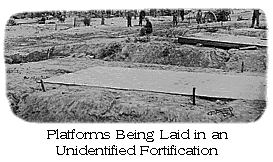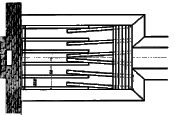 Platforms were used to support
the weight of a piece at an embrasure or barbette emplacement to prevent
the piece from sinking in soft soil and to help keep the wheels of the carriage
level so that the piece could fire accurately. The nature and strength of
platforms depended on the type of cannon and carriage they had to support.
Platforms for light field pieces could be as simple as three planks laid
bear on the ground to support the wheels and trail while heavy mortars might
require platforms of multiple stacked layers of thick planks. Most platforms
fell somewhere between these two extremes. Platforms were used to support
the weight of a piece at an embrasure or barbette emplacement to prevent
the piece from sinking in soft soil and to help keep the wheels of the carriage
level so that the piece could fire accurately. The nature and strength of
platforms depended on the type of cannon and carriage they had to support.
Platforms for light field pieces could be as simple as three planks laid
bear on the ground to support the wheels and trail while heavy mortars might
require platforms of multiple stacked layers of thick planks. Most platforms
fell somewhere between these two extremes.
Barbette carriages for heavy artillery only required
a cross piece for the pintle and perhaps a semi-circle of planking or thick
beams radiating outward from the pintle block to support the traverse circles.
Light field pieces could be supported by a platform that consisted of three
sleepers about 15 feet long laid perpendicular
 to the embrasure
under the wheels and trail. Planks at least two inches thick were laid on
the sleepers and nailed into place. The rear of the platform would be raised
about five inches higher than the front to help break the recoil of the piece
and drain rainwater off the platform. Heavy artillery mounted on siege carriages
needed more substantial platforms that consisted of 12 sleepers laid in two
rows, the second overlapping and at an angle to the first row. 36 planks to the embrasure
under the wheels and trail. Planks at least two inches thick were laid on
the sleepers and nailed into place. The rear of the platform would be raised
about five inches higher than the front to help break the recoil of the piece
and drain rainwater off the platform. Heavy artillery mounted on siege carriages
needed more substantial platforms that consisted of 12 sleepers laid in two
rows, the second overlapping and at an angle to the first row. 36 planks
 measuring five by three and one-half five inches were
laid on the sleepers and fastened with dowels. A headpiece, called a hurter
was placed at the front of the platform to prevent the wheels of the
artillery carriage from striking the revetment of the interior slope. The
hurter also allowed the piece to be run up to the embrasure and fired in
the proper direction at night. measuring five by three and one-half five inches were
laid on the sleepers and fastened with dowels. A headpiece, called a hurter
was placed at the front of the platform to prevent the wheels of the
artillery carriage from striking the revetment of the interior slope. The
hurter also allowed the piece to be run up to the embrasure and fired in
the proper direction at night.
[This page originally appeared as a Basic Information Page
on the old Civil War Field Fortifications Website.] |